Substack vs Medium: Comparing Two Popular Blogging Platforms
Feb 27th, 2024

Today, writers and bloggers have a wide choice of writing platforms to share their thoughts. Among the various options, Substack and Medium have emerged as two well-known players, each offering unique benefits and addressing different needs. Therefore, understanding the nuances of these platforms becomes crucial in making an informed decision about where to publish and build the online presence.
Whether it's the simplicity and customization of Substack or the broader community and curation tools of Medium, this article aims to guide writers in choosing the platform that aligns best with their goals and aspirations. This article will compare the websites and shed light on their key features, benefits, and drawbacks.
What is Substack?
Substack is a website that allows writers to create and publish newsletters. It helps authors connect with their audience, share content, and monetize their work through paid subscriptions. On Substack, writers can offer free or paid subscriptions to their newsletters, giving readers access to regular updates, articles, and other content. Subscribers receive these updates directly in their email inboxes.
Substack gained popularity for its user-friendly interface, making it easy for writers to set up and manage their newsletters without needing advanced technical skills. The platform also offers tools for writers to engage with their audience, including options for comments and discussions, creating a community around the content.
While Substack allows authors to reach their audience directly, it has also sparked discussions about the changing landscape of media and journalism. Some see it as an empowering tool for individual writers to gain financial support from their readers. However, there have been debates about the potential challenges, including concerns about the platform's sustainability, the role of traditional media outlets, and misinformation issues.
Let's now consider the features of another popular platform, Medium.
What is Medium?
Medium is an online publishing website that allows individuals to share and discover articles on a wide range of topics. Medium was launched in 2012 by Evan Williams, one of the Twitter creators. The platform helps writers share their ideas, stories, and expertise with a broader audience.
On Medium, users can create a profile and start writing articles, known as stories. The platform offers a neat and minimalist design, making it easy for copywriters and readers to focus on the content. Medium also incorporates a social element, allowing users to follow each other, recommend articles, and leave responses.
A distinctive feature of Medium is its Partner Program, which enables writers to earn money based on readers’ engagement with their stories. Members who subscribe to Medium's premium service pay a monthly fee, and a portion of that subscription payment goes to writers.
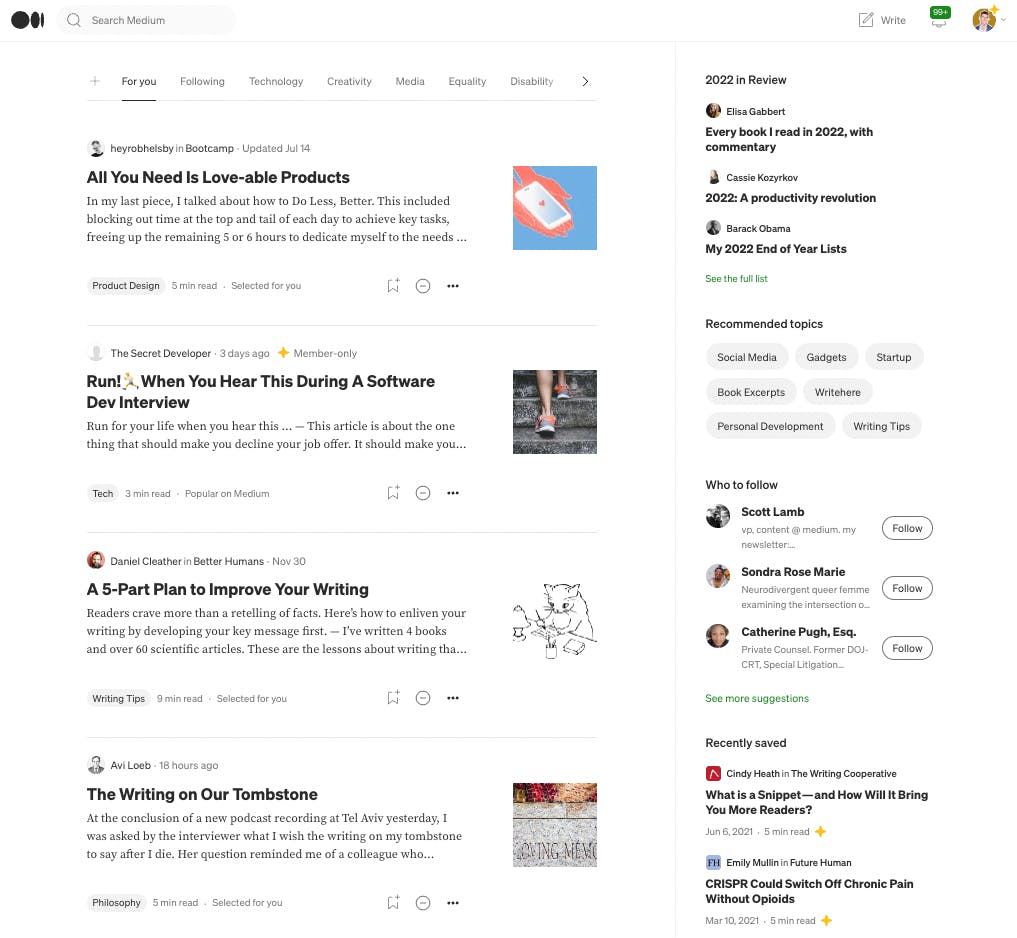
Let us explore the similarities and differences between these platforms and compare them regarding features, functionality, audience acquisition, monetization options, and other characteristics.
How do Substack and Medium compare?
Now, we will discover the key features and functions of two prominent writing platforms: Substack and Medium. Both platforms have played significant roles in reshaping the landscape of online content creation and publishing.
Features and functionality
Both platforms offer user-friendly interfaces and provide text editors and formatting tools, making it easy for creators to create visually appealing content. Substack and Medium have mobile apps for iOS and Android, allowing writers to manage their content and engage with their audience.
Using search and recommendation features, readers can easily find new content on both platforms. Moreover, both Substack and Medium facilitate notifications and engagement features, allowing writers to stay connected with their audience through comments, social sharing, and other interactive elements.
However, there are significant differences between these platforms. Substack specializes in email newsletters, primarily focusing on delivering written content directly to subscribers' inboxes. Medium, on the other hand, is not limited to newsletters and supports a broader range of content types, including articles, essays, and stories.
In addition, recently, Substack introduced its short-form content feature, Notes, drawing attention for its uncluttered design and similarity to Twitter. Notes allow users to share text or photos in a concise format. The feature distinguishes itself from Substack's primary product by providing a unique experience and serving as an extension to the platform.
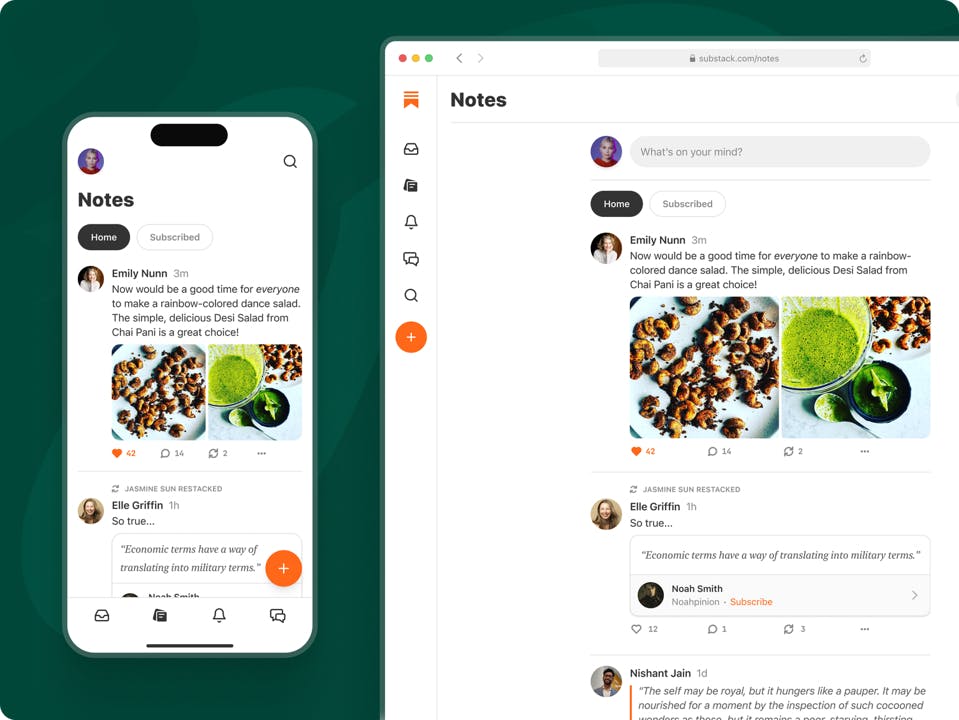
Audience acquisition and content distribution
Substack is known for its subscription-based model. Creators can offer paid subscriptions to their newsletters, and readers can directly support their favorite writers. Medium uses a metered paywall model. Readers get a certain number of free articles per month, and beyond that, a subscription is required to access premium content.
On Medium, there is a distinction between followers and subscribers. Subscribers are individuals who receive new articles directly in their email inbox, and you can export this list for various purposes. At the same time, you don't have the option to export the list of followers. In contrast, Substack subscribers simultaneously function as followers on the platform.
While Medium users can find articles through topic tags, recommendations, and the platform's main feed, Substack readers must subscribe to a specific newsletter. For this reason, it might be more challenging for new Substack writers to gain visibility without external promotion. Moreover, there isn't a centralized platform-wide feed for discovering content. Medium has a more robust built-in discovery system, where stories are recommended to users based on their interests and reading history.
In addition, Substack allows writers to have a public archive of their newsletters, potentially benefiting from SEO. However, the main focus is often on the email subscription model. Medium places significant emphasis on SEO, and articles can rank in search engine results, potentially attracting a larger audience.
Monetization options
When using Substack, writers can set prices and charge readers a subscription fee to access their premium content. Substack handles payment processing and takes a percentage, typically around 10%, of the subscription revenue. Besides this, Substack provides promotional deals to help creators attract more subscribers. These deals may include upfront payments or promotional support.
Medium offers a Partner Program where writers can earn money based on the engagement their stories receive. It includes reading time and claps, Medium's equivalent of likes. Users subscribe to Medium for a monthly fee, and a portion of that payment goes to writers based on their engagement with their stories.
Medium writers can put their stories behind a paywall, making them accessible only to platform members. Furthermore, Medium introduced an audio version of stories, allowing authors to earn money based on the time users spent listening to their audio content.
Therefore, the author’s earnings on Substack are primarily based on the number of paid subscribers. High-earning writers often have large and dedicated subscriber bases. At the same time, earnings from the Medium Partner Program depend on the readership's engagement with your stories. Thus, the success on the platform often depends on the quality and relevance of the content, as well as the creator's ability to attract and retain readers.
Advanced integrations and prices
Substack allows users to set up a custom domain for their newsletters, giving them more control over their brand and online presence. Medium also provides custom domains for individual writers. This is a web address that you can buy through a domain registrar like GoDaddy, Namecheap, or Google Domains and link to your Medium profile or publication.
Substack provides basic integrations, such as connecting to Stripe for payment processing. Medium has a more open platform, allowing for a variety of integrations. It supports the ability to include multimedia elements such as images, videos, and interactive features to enhance the storytelling experience. In addition, Medium supports embedding content from platforms like YouTube, Twitter, and others.
Customization and branding
Medium’s customization is limited compared to Substack. Writers can choose different formatting options for text and embed images and multimedia, but the overall design is standardized to maintain a consistent user experience across the platform.
Medium allows writers to add a profile picture and cover photo to their profiles, contributing to a basic level of personal branding. However, within individual stories, branding options are restricted to maintain a uniform reading experience for users. Writers on Medium can create an author bio and add links to their social media profiles. Still, the customization of individual story pages is restricted, and there's no dedicated space for comprehensive custom pages.
Substack provides more design flexibility compared to Medium. Digital creators can customize the appearance of their newsletters, including choosing color schemes, fonts, and layout options. It allows for a more personalized and branded look for each newsletter. Furthermore, Substack lets writers upload a profile picture and banner image and create custom landing pages for their newsletters, including an about section, providing the ability to create a distinct online identity and maintain consistency in building the brand.
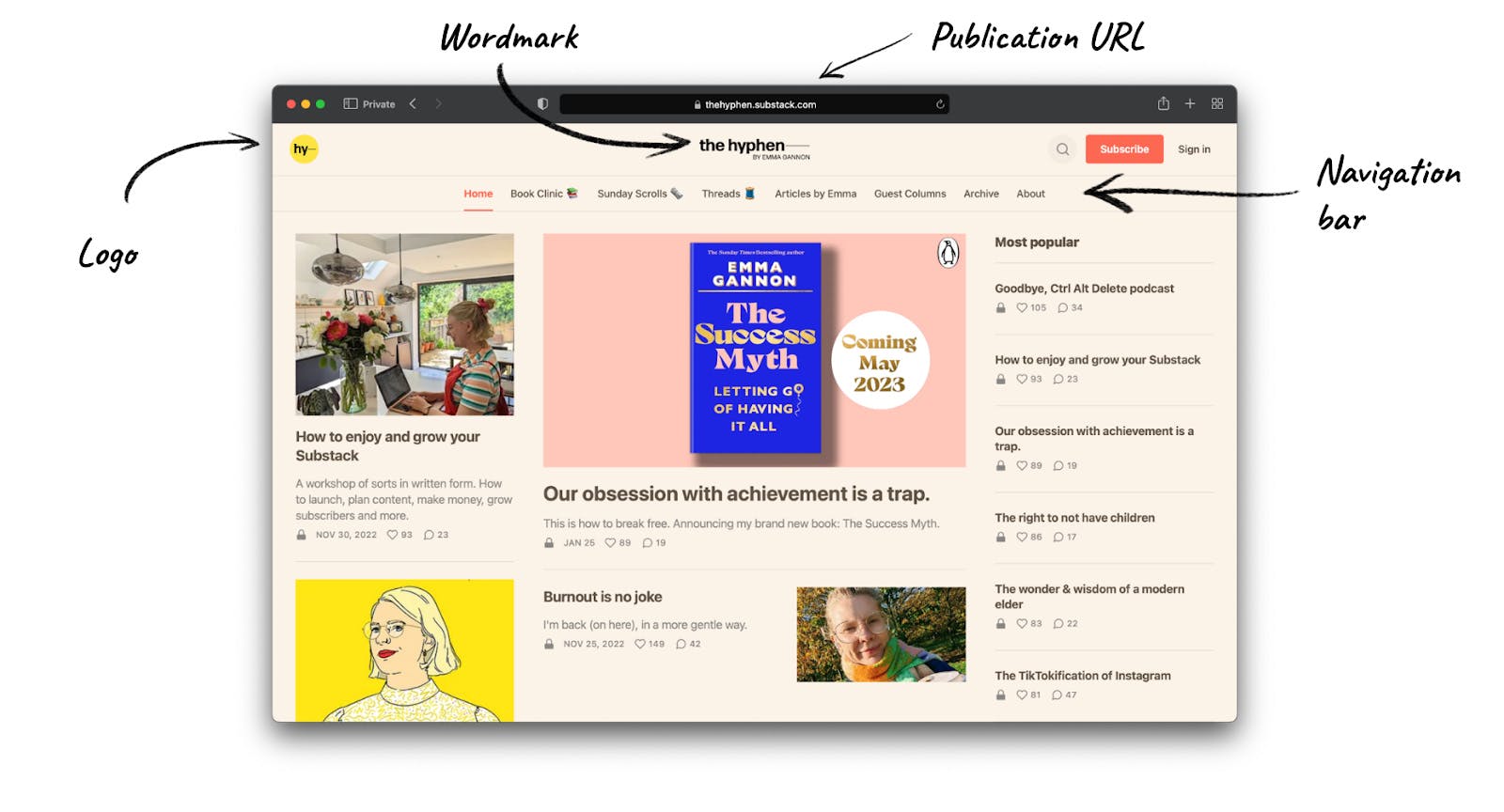
Community and collaborations
Medium allows writers to create and contribute to publications, which are collections of stories dedicated to a particular topic. Publications can have editors who curate and manage content, and authors can submit their articles for consideration to be included in the publication. The audience can leave comments on articles and share them on various social media platforms.
Substack’s format encourages a more personal and direct connection between writers and readers. While the platform allows for comments on newsletter issues, comments are typically private within the email. Substack generally puts more control in the hands of individual writers, and collaborative efforts within newsletters are managed by the primary author.
Therefore, Medium's community is often centered around publications and the broader platform, while Substack's community is built around individual writers and their newsletters. Substack's collaboration features are more limited, focusing on guest posts or interviews within individual newsletters.
Content ownership
Both Substack and Medium writers can export their email subscriber list at any time, allowing them to migrate to another platform. Substack authors can make their newsletters free or paid, and they retain the rights to their work. Thus, content can be republished elsewhere, as writers retain ownership.
Authors on Medium grant the platform a license to host and display the content, but the ownership remains with the writer. Authors can export their content, but migrating to another platform is limited, especially if the content is part of the Medium Partner Program. In addition, creators can republish their content on other platforms, but engagement and earnings would be affected if it's behind Medium's paywall.
Consequently, Substack tends to provide writers with more direct ownership and control over their content. While Medium allows authors to retain ownership, it operates on a platform with its own monetization and distribution model. Both websites allow writers to export their content, but Substack offers more flexibility in migrating to other platforms.
Analytics and insights
Substack provides detailed analytics on the audience, including the number of readers, new subscribers, and unsubscribes. Writers can see which specific posts led to new subscriptions or lost subscribers. The platform also offers metrics on post engagement, such as open rates, read times, and click-through rates.
While neither platform provides extensive details on reader demographics, Substack allows writers to export their subscriber list, which can be used for more in-depth analysis. Writers can track how readers interact with their content and identify the most popular posts. For paid newsletters, Substack provides information on earnings, including the number of paying subscribers and revenue generated.
Medium provides data on the number of views and reads for each article, helping writers analyze the popularity of their content. The platform calculates a Read Ratio, indicating the percentage of readers who finished reading the entire article. This metric can provide insights into content engagement. In addition, creators can track the growth of their follower base on Medium over time.
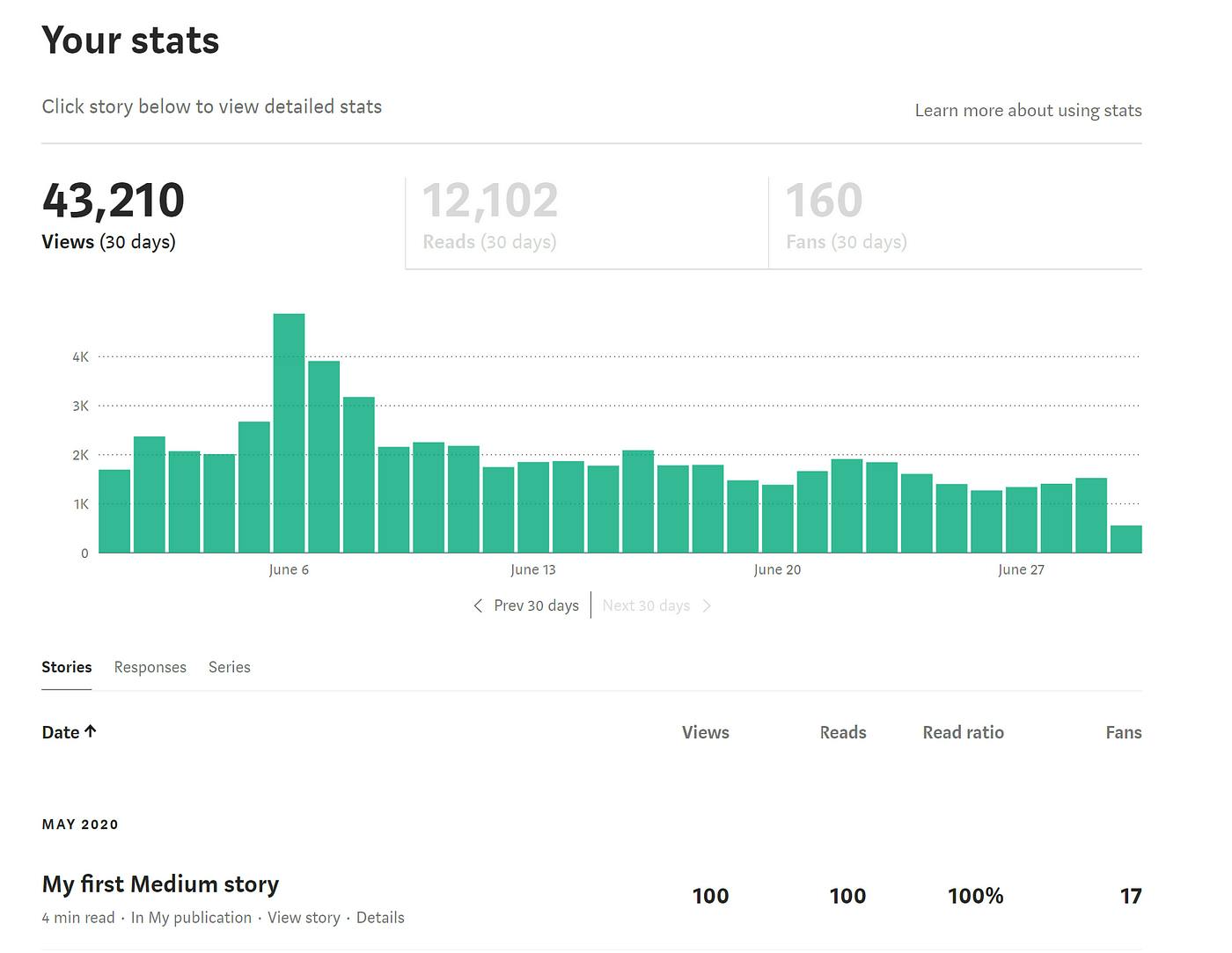
Thus, Substack offers more detailed analytics, especially about subscriber-related metrics and revenue tracking for paid newsletters. Both platforms provide engagement metrics, but the specific data may vary. Substack offers information on open and click-through rates, while Medium focuses on views, reads, and the Read Ratio.
Substack's analytics dashboard is known for its convenient interface, making it easy for writers to access and understand their performance metrics. Medium's analytics are also accessible, but the emphasis is on the overall reach and engagement rather than detailed revenue tracking.
In summary, while both Medium and Substack offer features for building and engaging with a community, they have distinct approaches in terms of content format, monetization, and community structure. The choice between the two may depend on the type of content you create, your engagement goals, and your preferred format for reaching your audience.
Try it for yourself!
In conclusion, exploring platforms like Medium and Substack can be an enriching experience for both readers and writers alike. Each platform offers a unique set of features and characteristics that cater to different preferences and objectives.
Medium is known for its clean and user-friendly interface. It operates on a subscription-based model, offering readers a seamless, ad-free experience. The Partner Program allows writers to earn revenue based on reader engagement, creating an incentive for quality content creation. The curation system on Medium also ensures that well-crafted articles can reach a wider audience, enhancing the discoverability of your work.
On the other hand, Substack has gained popularity as an email newsletter platform, strongly emphasizing direct and personalized communication between writers and their audience. It empowers authors to monetize their content through subscription models, fostering a direct relationship with their readers. So, to choose which platform would be the best option, try to understand your needs and compare them to the features of each platform. Or you can try both and focus on the one that will eventually work best for you!
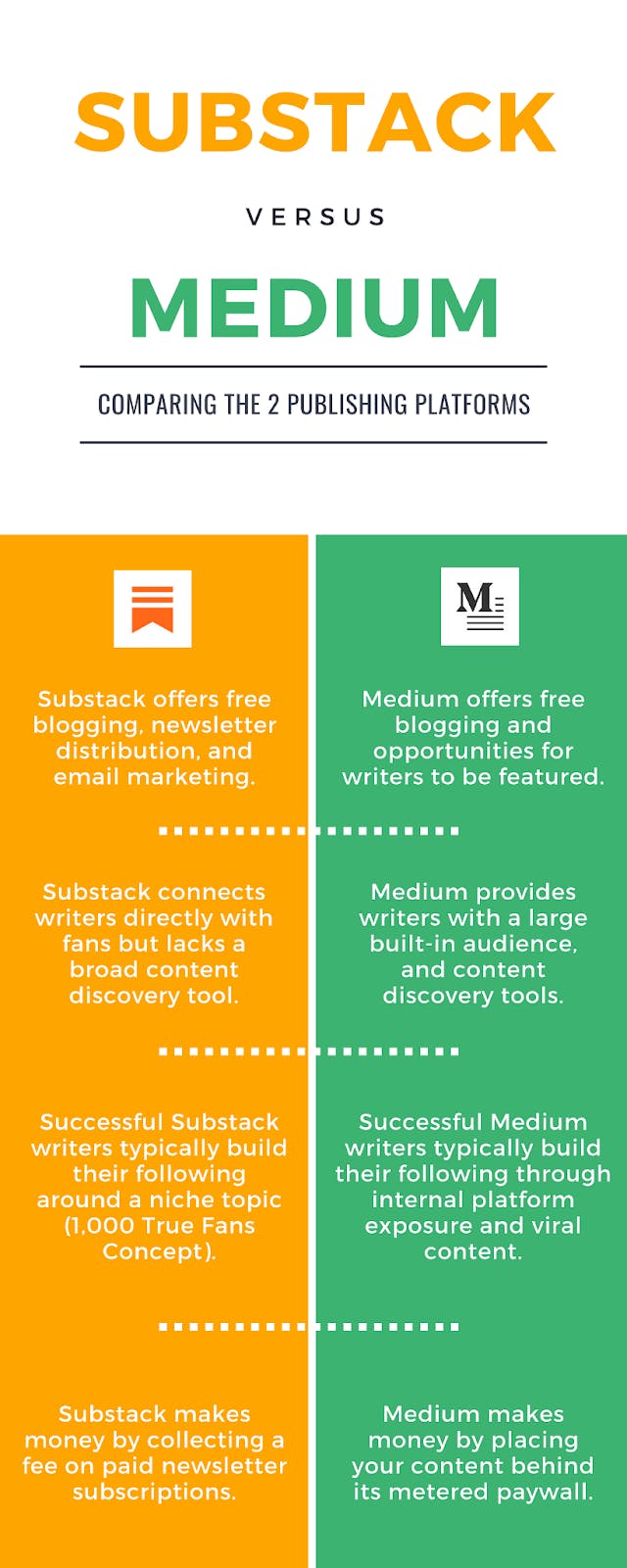
Substack's simplicity and focus on individual newsletters make it an excellent choice for creators who prefer a more personal and independent publishing approach. The platform is free to use, with the option for writers to charge a subscription fee for premium content, giving them control over their revenue stream.
When selecting between Medium and Substack, consider your goals and preferences. If you value a broad readership, exposure, and a platform that rewards quality copywriting, Medium might be the right fit. If you prioritize direct engagement with a dedicated audience, prefer a subscription-based model, and appreciate the simplicity of newsletters, Substack could be the ideal choice.
Ultimately, both platforms offer valuable tools and opportunities for writers, and the best choice depends on your unique writing style, audience engagement strategy, and overall publishing goals. So why not embark on this digital adventure and find the platform that best fits your ambitions for creativity?
